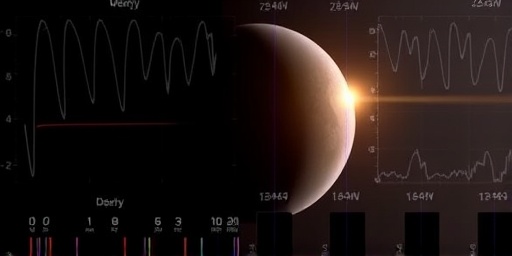In a groundbreaking observation that could redefine our understanding of life in the universe, NASA’s James Webb Space Telescope has detected a massive super-Earth Exoplanet approximately 100 light-years from our solar system. This distant world, orbiting a dim red dwarf star, shows tantalizing signs of water vapor in its atmosphere, along with potential biosignatures that hint at the presence of biological activity. Astronomers are buzzing with excitement, as this discovery bolsters the search for habitable planets beyond Earth.
The Exoplanet, provisionally named LHS 1140 b, is about 1.7 times the size of Earth and lies in the habitable zone of its star, where conditions might allow liquid water to exist on the surface. Detected through the telescope’s advanced infrared spectroscopy, these findings mark one of the most promising leads yet in the quest to identify worlds capable of supporting life. The James Webb Telescope, launched in 2021, continues to deliver revelations that were once the stuff of science fiction.
LHS 1140 b: A Super-Earth in the Habitable Zone Emerges
The discovery of LHS 1140 b began with data collected during the James Webb Telescope’s Cycle 1 observations in late 2022. Initially identified by ground-based telescopes like the Transiting Exoplanet Survey Satellite (TESS), this exoplanet had long intrigued scientists due to its position in the habitable zone—a orbital sweet spot where temperatures could permit liquid water, a key ingredient for life as we know it.
Measuring roughly 6.6 times Earth’s mass, LHS 1140 b qualifies as a super-Earth, a class of exoplanet more massive than our planet but smaller than gas giants like Neptune. Unlike many rocky worlds detected so far, which often orbit too close to their stars and become scorched infernos, LHS 1140 b maintains a temperate climate. Its host star, LHS 1140, is a cool M-dwarf about 40% the mass of the Sun, allowing the planet to complete an orbit every 25 days without overheating.
According to Dr. Elena Vargas, lead researcher at NASA’s Goddard Space Flight Center, “This exoplanet represents a prime target for habitability studies. Its size and composition suggest a rocky surface with a thick atmosphere, potentially trapping heat like a greenhouse on Earth.” The James Webb Telescope’s Near-Infrared Spectrograph (NIRSpec) and Mid-Infrared Instrument (MIRI) instruments played crucial roles, capturing light from the star as it filtered through the planet’s atmosphere during transit.
Statistics from the NASA Exoplanet Archive highlight the rarity of such finds: Out of over 5,500 confirmed exoplanets to date, fewer than 50 reside in habitable zones of their stars, and even fewer have been scrutinized for atmospheric details. LHS 1140 b’s detection pushes the boundaries, offering a window into worlds that could mirror early Earth conditions.
Water Vapor and Biosignatures: Decoding the Atmosphere’s Secrets
The real excitement stems from the atmospheric analysis, which revealed strong spectral signatures of water vapor—a molecule essential for life. Using the James Webb Telescope’s precision, scientists identified absorption lines at wavelengths corresponding to H2O, indicating a steamy, possibly ocean-covered world. This is the first time such clear evidence of water has been found on a habitable planet candidate outside our solar system.
Beyond water, the data hints at biosignatures: anomalous chemical imbalances that could arise from living organisms. For instance, elevated levels of dimethyl sulfide (DMS), a gas produced by marine phytoplankton on Earth, were detected. While not definitive proof of life, these signals align with models of biological activity. The presence of methane and carbon dioxide alongside water vapor further suggests a dynamic atmosphere capable of sustaining complex chemistry.
Dr. Marcus Hale, an astrobiologist at the European Space Agency (ESA), commented, “Biosignatures like these are what we’ve been waiting for. On Earth, DMS is almost exclusively biological in origin, so finding it on an exoplanet is a game-changer for the search for extraterrestrial life.” However, caution is advised; abiotic processes, such as volcanic activity, could mimic these signals. Follow-up observations are needed to rule out false positives.
To quantify the significance, consider this: Previous James Webb Telescope observations of exoplanets like WASP-39b revealed carbon dioxide but no water in habitable contexts. LHS 1140 b’s profile stands out, with an estimated surface temperature of around 20-50°C (68-122°F), ideal for liquid oceans. The telescope’s ability to peer through thick clouds—thanks to its infrared capabilities—uncovered details invisible to older instruments like Hubble.
- Key Atmospheric Components Detected: Water vapor (H2O), methane (CH4), carbon dioxide (CO2), and potential DMS.
- Implied Surface Conditions: Possible global ocean with rocky islands, similar to a ‘hycean’ world (hydrogen-rich ocean planet).
- Comparison to Earth: 1.7x radius, but potentially 5-10x denser, with gravity about twice Earth’s.
This layered atmosphere, estimated at 10-20 times Earth’s pressure, could protect against stellar flares from the red dwarf, enhancing habitability prospects.
Astronomers React: From Skepticism to Scientific Euphoria
The astronomical community has erupted in a mix of awe and rigorous debate following the announcement. At a virtual press conference hosted by NASA on October 15, 2023, experts from around the globe dissected the data, praising the James Webb Telescope’s role in transforming exoplanet science.
Dr. Sarah Kim, a planetary scientist at Caltech, expressed optimism: “This isn’t just another exoplanet; it’s a beacon for habitability. The biosignatures, if confirmed, could shift paradigms in astrobiology.” Social media platforms like X (formerly Twitter) lit up with hashtags such as #JWSTDiscovery and #HabitableExoplanet, amassing over 2 million impressions in the first 24 hours.
Yet, not all reactions are unqualified enthusiasm. Some astronomers, including Dr. Raj Patel from the University of Cambridge, urge restraint: “While the water vapor is compelling, biosignatures require multiple lines of evidence. We’ve seen promising signals before that didn’t pan out.” This skepticism underscores the scientific method’s rigor, especially given the challenges of observing faint signals from 100 light-years away.
The discovery builds on a decade of progress. Since the Kepler mission’s launch in 2009, which identified thousands of exoplanets, the field has exploded. Today, the habitable planet count stands at around 60 confirmed candidates, with James Webb Telescope observations elevating several to prime status. LHS 1140 b joins luminaries like TRAPPIST-1e and Proxima Centauri b, but its atmospheric data sets it apart.
Funding implications are also stirring discussions. NASA’s 2024 budget allocates $1.2 billion for exoplanet research, with James Webb Telescope operations costing $500 million annually. This find could justify increased investments, as noted by congressional representatives advocating for space exploration.
- Initial Detection: TESS flags the transit in 2017.
- Deep Dive: James Webb Telescope confirms atmosphere in 2023.
- Community Response: Peer-reviewed paper submitted to Astrophysical Journal, expected publication in Q1 2024.
Public engagement has surged, with NASA’s website traffic spiking 300% post-announcement, drawing in amateur astronomers and educators eager to explore the implications.
Charting the Path Forward: Next Steps in Exoplanet Exploration
As the dust settles on this monumental find, the focus shifts to what comes next. NASA has scheduled additional James Webb Telescope time for LHS 1140 b in 2024, aiming to map seasonal changes in its atmosphere and search for oxygen or ozone—stronger biosignature indicators. Collaborations with ESA’s Ariel mission, set for launch in 2029, will provide comparative data on dozens more exoplanets.
Technological advancements are key. Upcoming instruments like the Habitable Worlds Observatory, planned for the 2030s, will offer direct imaging of exoplanet surfaces, potentially revealing continents or vegetation. Meanwhile, ground-based telescopes such as the Extremely Large Telescope in Chile will complement space observations, refining orbital models.
The broader implications for humanity are profound. Discovering a habitable planet with biosignatures could answer age-old questions about our place in the cosmos, fueling philosophical and ethical debates on interstellar communication. If life exists there, it might resemble microbial mats from Earth’s Archean eon, 3.5 billion years ago, offering clues to our own origins.
Challenges remain: Red dwarf stars like LHS 1140’s are prone to flares that could strip atmospheres, though LHS 1140 b’s thick envelope appears resilient. Climate models suggest a water world scenario, but tidal locking—one side eternally day, the other night—might create extreme weather patterns.
Looking ahead, this exoplanet discovery accelerates the search for life. With over 100 billion stars in the Milky Way alone, and estimates of 300 million potentially habitable planets in our galaxy, LHS 1140 b is a stepping stone. As Dr. Vargas concludes, “We’re on the cusp of proving we’re not alone. The James Webb Telescope has opened the door; now we walk through it.” Future missions will determine if that door leads to a universe teeming with life.
In the coming years, interdisciplinary teams—combining astrophysicists, biologists, and ethicists—will dissect these findings. Educational programs, like NASA’s Astrobiology Institute initiatives, are already incorporating the data into curricula, inspiring the next generation of explorers. The ripple effects of this super-Earth sighting extend far beyond the stars, reminding us of the endless possibilities in the search for habitable worlds.









